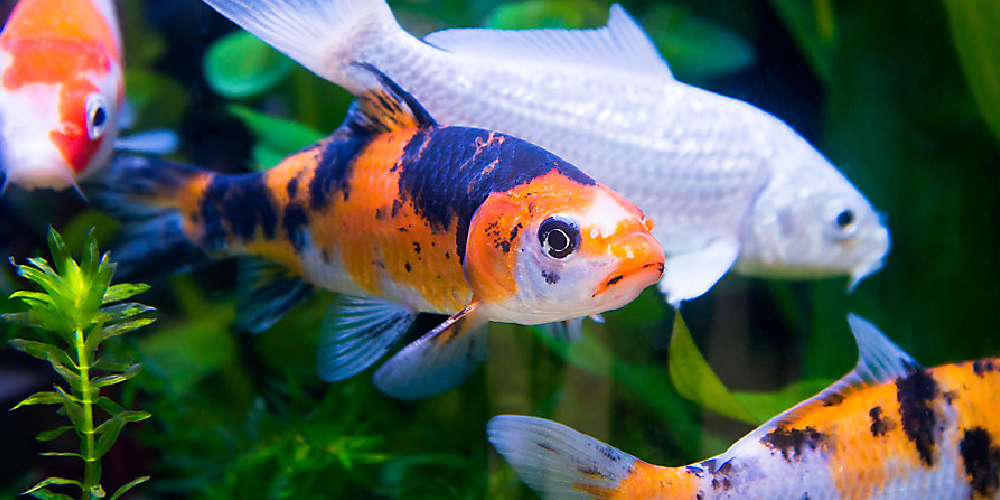Aquariums are often the focal point of any room, but they also offer various other benefits, such as reducing stress and lowering blood pressure, while helping the occupants of the room to relax, re-focus, and recharge their batteries. There are various freshwater fish for aquariums that are suitable for small and medium-sized spaces, and this blog discusses the ten best available options!
1. Goldfish
Goldfish are one of the most preferred choices when it comes to the perfect freshwater fish for your aquarium. The goldfish is a well-liked freshwater aquarium fish and is an ideal choice for any aquarium that is 20 gallons or more. This species can grow up to 14 inches long and can live up to 25 years or longer.
There are various shapes, sizes, colors, and breeds of goldfish available, but most require routine maintenance such as weekly water changes and filtration systems. They are easily recognizable and can act as ideal pets for children.
2. Angelfish
Angelfish belong to the Cichlidae family, which also includes several other fish species that are popular with aquarium keepers, such as discus fish, oscars, and parrotfish. Found in a variety of colors and patterns, the angelfish can grow up to 6 inches in length.
However, angelfish are an omnivorous species which means that they require a balanced diet of meat and plant food. There are various types of angelfish and require tanks that are at least 20 gallons, with the water being soft and acidic. Angelfish can become aggressive as they age, but this generally only happens in overcrowded tanks.
3. Rainbowfish
Originating from Australia and Southeast Asia, rainbowfish are calm, peaceful schooling fish that can grow up to 6 inches in length. Rainbowfish are not commonly seen in aquariums, and their colors only begin to show as they enter adulthood.
When shown the right care, these fish display stunning and vibrant colors within a few years as they begin to mature and age. They also get along well with other upper-level schooling fish such as danios, barbs, and larger tetras but can seem shy in a crowded tank full of colorful live freshwater fish.
4. Guppies
Popular due to their colorful looks and lively nature, guppies are also quite versatile and are able to adapt to a variety of water conditions. This makes guppies a favored choice amongst aquarium owners. They also require minimal maintenance, which is an additional benefit of guppies in your aquarium.
Male guppies tend to be more colorful and vibrant than females and are generally preferred unless they are being kept for breeding purposes. Guppies can survive in water at temperatures ranging from 50°F to 84°F (10–29°C), but it is important to keep the temperature of the water constant. The ideal diet for these fish is a mixture of plant and animal-based foods.
5. Mollies
Small, peaceful, and strikingly colored, molly fish can grow to around 3-4 inches and are able to easily adapt to a variety of water conditions. Aquariums that are 20 gallons or more are ideal for this species of fish alongside warm water with a pH between 7.0-7.8.
Molly fish are omnivorous, which means that their diet needs to consist of both plant and animal food. One of the most interesting facts about molly fish is that they are livebearers, meaning they give birth to their young ones rather than laying eggs. Molly fish require minimum maintenance but breed quite easily.
6. Neon Tetra
Neon tetras are usually one of the first fish a beginner aquarist will buy. They are small in size, brilliantly colored, and easy to care for, which makes them an ideal choice for newbies. Tetras reach around 2.2cm in length and prefer being kept in groups.
Neon tetras can be found in a variety of colors and have iridescent blue horizontal strips across their bodies. They need soft, acidic water with tropical temperatures and can survive on most diets, including brine shrimp, worms, and insects, as well as plants, as they are omnivores.
7. Zebra Danios
Zebra Danios is an excellent choice for beginner aquarists as they are very easy to care for and can grow up to 7cm. They can also survive in smaller tanks, but it is recommended that tanks containing zebra danios should be at least of 10 gallons. Since Danios are schooling fish, they will become stressed if their numbers are too low.
Zebra Danios can survive on most foods, but a healthy, ideal diet for them could include lots of worms, insects, and crustaceans to help mimic their natural diet. High-quality flake supplemented with frozen or live food is also a suitable diet. Danios are also known to jump, so it is best to have a covered aquarium.
8. Platies
Platy fish are perfect for those who want colorful fish in their aquarium. Platy fish can be found in almost every color and are extremely easy to care for. They are also a great fish to have in your tank as they are very peaceful and get along well with guppies, mollies, and most other fish.
Platies are quite active and prefer being in groups with a 10-gallon tank having enough space for five or six fish. Platies are omnivorous, but their diet needs to consist mostly of herbivorous foods rather than being meat-heavy.
9. Oscar
Oscar fish are widely considered as one of the most intelligent freshwater fish for aquarium and are amongst the rare few species of fish that can be trained to do tricks. However, they are not community species and need to be kept in species-only tanks. They can also grow very large quite quickly and require a lot more maintenance than most other species of fish.
Oscars bloom when kept in pairs or groups of 5+, but it is recommended that they should be housed together from a young age. They also create more waste than other fish due to being carnivorous.
10. Swordtails
Swordtails resemble platies and guppy fish with their shape but are slightly bulkier, along with having a sword-shaped extension of their fins. They are available in a variety of different color variations and are a suitable choice for beginner aquarists.
This species of fish is peaceful yet lively and can thrive in community tanks with other fish. However, they do breed easily, which can be prevented by only keeping either male or female fish. If they do breed, the offspring should be kept separate from the parents, as swordtail parents will often eat their fry.
Final words
For an aquarist, there are many types and species of freshwater fish for aquariums that are ideal. While some fish are easier to look after than others, the choice often comes down to personal preference. If you too are a fish lover and want to add some adorable fish to your collection, end your hunt right away and reach out to Koi Kompanion to add more beauty and variety to your aquarium and give it a superior touch.




